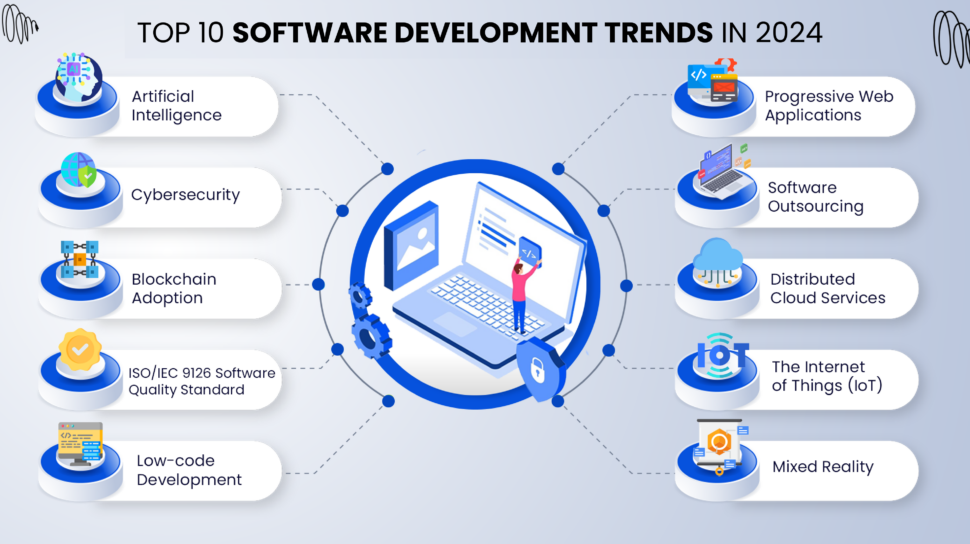The software development industry continues to expand with remarkable advancements in technology. The validation of this can be seen in the global revenue of the software market, which hit $608 billion in 2022 compared to $597.3 billion in 2019 (Source: MarketResearch.com and Statista). A report by Statista also indicated that the global software market may witness a CAGR of 5.78% between 2022-2027 which will take the software market revenue to $806 billion by 2027.
Only the ever-changing and latest software development trends can cause such growth so a popular and constant question among business personnel is: What are the latest software development trends?
Let’s answer them today by looking into the most recognized trends in the software industry:

1. Artificial Intelligence
Artificial intelligence is now considered one of the rapidly emerging technologies in software development. It powers applications like chatbots, machine learning algorithms, text/image recognition software, and data filtering. The value of the global AI market reached $328 billion in 2021 and it may further increase to $1,394 billion with a CAGR of 20.1% by 2029.
Narrow AI is currently the most popular and the only operational form of AI. Its algorithm focuses on single goals like speech recognition, spam email filtering, music recommendations, and chatbots. Active use of AI applications leads to better-informed decisions and customized consumer experience, a reason why IT giants like Microsoft and startups such as Narrative Science and Cynere keep heading toward huge profits by integrating AI into their business.
2. Cybersecurity
Cybersecurity is also one of the rapidly growing software industry trends after AI. It is now on the list of software technologies headed toward continuous growth. Cyber-attack threats will likely increase soon as the world gets more digitally interlinked. That is why cybersecurity systems have become essential in various business sectors, making them one of the trending software technologies in the world.
According to a report by MarketsandMarkets, the value of the cybersecurity market may reach $240.27 billion in 2022 compared to $217.87 billion in 2021.
3. Blockchain Adoption
Blockchain is no other new technology in software development anymore. Business sectors like automotive, agriculture, and logistics will soon adopt this technology and the number of blockchain-based applications will grow fast in 2024. The technology provides top-tier security with all transactions taking place in your business.
The features of blockchain-oriented software systems like data replication, decentralized systems, public-key cryptography, and immutable transaction records are leading the technology adoption to its ever-growing popularity.
4. ISO/IEC 9126 Software Quality Standard
There was no international standard for measuring the quality and integrity of a software system before ISO/IEC 9126. It is a software quality standard that helps determine trustworthiness, dependability, and resilience in software applications by calculating quality measures based on the number of weaknesses in the software.
ISO/IEC 9126 helps identify and remove structural weaknesses in the software during the development process. It helps companies create a better reputation and make an impression on multiple clients with the guarantee of high-quality software products.
5. Low-code Development
Software engineering is hastily moving towards a streamlined approach to building apps with solutions like low-code/no-code development (LCNC). Low code development is now at the core of modern software development practices as it helps developers build applications with minimal coding and provides a way for everyone to program applications without expert linear coding.
The visual drag-and-drop applications (graphical user interface) and similar tools of LCNC make this possible. Individuals with no experience in coding can effortlessly develop their ideas into applications due to LCNC. All this makes low code development an economical choice for a new firm that requires fast prototyping and testing of the business concept.
The global revenue value of the low code platform reached $13 billion in 2020 and it is predicted to reach $65 billion by 2027 with a CAGR of 26.1%. That is why it is currently one of the most influential trends in software engineering.
Notable examples of low-code applications are WordPress, Weebly, Wix, and Squarespace.
6. Progressive Web Applications
Progressive web applications are a native solution that integrates the functions/features of a website into a mobile application. They are the latest software development technologies with the potential for unlimited growth. You can download such applications quickly from the website and put them on your smartphone home screen. It defeats the need to go to the app store for downloading.
PWAs are like native apps with advanced performance, small size, and features like push notifications and offline mode. They are the most viable options for small/new companies as they are less expensive to create and maintain, plus give them the benefits of both mobile and web. More small businesses and startups are likely to choose progressive web applications in the near future.
Starbucks, Debenhams, BMW, and Flipboard are some prominent examples of PWAs.
7. Software Outsourcing
Outsourcing software development trends have become the first choice for companies that strive to protect company resources/money from a costly in-house team. It is also not easy to find IT professionals capable of delivering top-of-the-line software projects on time and for all sectors.
The value of global IT outsourcing is $440.41 billion in 2022 compared to 413.80 billion in 2021 and it is expected to reach 610.12 billion by 2027 with a CAGR of 6.68%. Software outsourcing can lead to rapid growth, cost efficiency, better quality, lower risks, and protect company resources.
8. Distributed Cloud Services
Software development companies will all soon turn to distributed cloud services. These cloud-native solutions prove lucrative for development teams, especially as they facilitate remote work and lead to software industry growth.
Companies can use a distributed cloud topology rather than putting backend services on a single cloud server as these are hosted by several cloud providers and in different geographical regions, leading to less to zero downtime error.
Netflix and YouTube are the two most well-known examples of apps working on distributed cloud services.
9. The Internet of Things (IoT)
One of the crucial technological developments in 2024 will be the rise of the Internet of Things (IoT). It has changed everyday lifestyles by linking sensors, gadgets, machinery, and automobiles. IoT also provides several benefits to businesses like the solutions to collect large quantities of data, expedite various operations, prevent equipment malfunction, conduct inventory management without losses, and save operational expenses.
Activity trackers, automated self-healing systems, anti-theft smart tags, home security systems, and biometric cybersecurity scanners are common examples of IoT.
10. Mixed Reality
Mixed reality represents the fusion of reality and virtual worlds like AR (augmented reality) and VR (virtual reality). It forms an immersive environment with interactive physical or digital objects. You can use mixed reality to build native apps for restaurants, real estate, and other businesses.
Mixed reality interfaces can guide your staff through even the most complex procedures. The HoloLens, virtual furniture fitting, 3D modeling, Snapchat filters, and virtual makeup are some examples of mixed reality.
Keep Up With the Trends
The software development statistics indicate irrefutable changes are coming for the IT sector due to current software development trends. The best way to respond to it is by integrating your business with those trends and staying up-to-date with all the upcoming ones.
You should talk to a professional software development company like- Ailoitte if you want to modernize your business with software industry trends. We can keep your business up to date with current ones and make you aware of the upcoming trends that can benefit your business whether they are software development trends in Healthcare Tech, FinTech, EdTech, Ecommerce, etc.
Frequently Asked Questions
The list of latest and promising software development trends includes Artificial Intelligence, Cybersecurity, Progressive Web Applications, Blockchain Adoption, Mixed Reality, The Internet of Things (IoT), Distributed Cloud Services, Software Outsourcing, Low-code Development, and Software Quality Standards.
Trends like Distributed Cloud Services, Low-code Development, and Artificial Intelligence are making a lasting impact on the software development industry.
You can keep up or even stay ahead of the latest software development trends by getting regular expert updates from an established Software development agency like Ailoitte.


















.png)
.png)
.png)



This is a great summary of the top trends in software development for 2024. I especially like how you explain the benefits of each trend and provide real-world examples. This is a valuable resource for anyone looking to stay ahead of the curve in the software industry.
This is a comprehensive overview of the top software development trends for 2024, Sunil! I especially appreciate the inclusion of the FAQ section. This is a valuable resource for anyone in the software development industry.